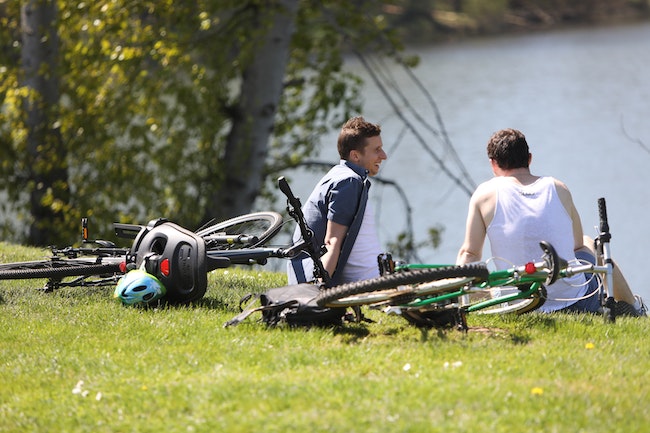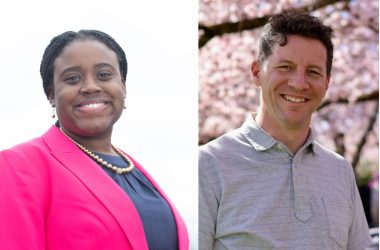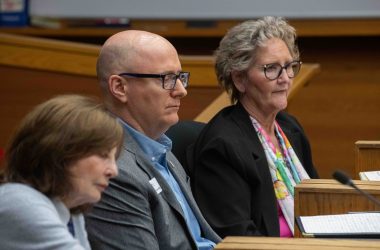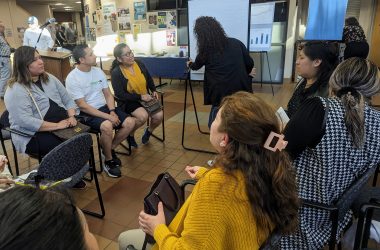
Jost Rist, left, of Salem, and Noah Grunberg, of Keizer, chat at Riverfront Park on Thursday, April 9. “It’s my first time out in two weeks, we’re all just trying to find some human connection,” said Grunberg. (Amanda Loman/Salem Reporter)
After receiving 1,600 survey responses, attending 120 meetings and consulting with 80 community groups, Salem City Planner Eunice Kim has crafted a draft vision for Salem’s future.
She worked with a team, culling survey responses and listening to community member’s input to form a series of goals for the next 20 years called “Our Salem.” The plan has been Kim’s focus for nearly two years.
“It’s been really gratifying. I’m really hoping that at the end of the day the vision reflects how (residents are) feeling and what their hopes and dreams are for the future,” Kim said.
The visioning process began more than a year ago and the city’s comprehensive plan isn’t expected to be complete until the end of 2021.
Residents can weigh in on the draft plan through a city survey.
LINK: Draft vision survey
Overwhelmingly, residents pointed to the need for more affordable housing. In one survey, 36% of respondents said they wanted multifamily housing spread throughout the city.
Single family housing makes up 66% of Salem’s housing mix and the draft vision said more diverse housing is needed in the future.
The city has state requirements it must follow to meet projections for housing and employment, like incorporating House Bill 2001, which requires triplexes or fourplexes to be allowed in areas zoned for single-family housing.
Kim said based on the draft rules, more than 90% of single-family zoned lots would have to allow a triplex. That doesn’t necessarily mean they will be built there, as that is largely dependent on the market.
One change seeks to create more flexibility in what can be built and where. For example, Northeast Lancaster Drive and Southeast Commercial Street are largely zoned commercial. Under the draft plan, those areas would become mixed use, which is defined as a pedestrian-friendly development that blends two or more residential, commercial, cultural, institutional or industrial uses.
Kim said it ties into another goal to reduce greenhouse-gas emissions by locating neighborhood hubs within communities, so people don’t have to travel as far to grab a coffee or go to the laundromat.
But one local environmental organization said the plan is disappointing because it isn’t aggressive enough on reducing the city’s emissions.
Phil Carver, a co-coordinator with the Salem chapter of the environmental group 350.org, said the Our Salem project was too weak on climate goals and should be integrated with the climate action plan that is underway. The draft vision says the city’s aims to reduce greenhouse gas emissions but doesn’t establish a specific target.
Carver wrote to City Manager Steve Powers on Sept. 21 and said: “Land use and development patterns are key factors affecting Salem’s greenhouse gas emissions from vehicles.”
He wrote that transportation emissions accounted for 53%of Salem’s direct greenhouse gas emissions in 2017.
“Increasing the tree canopy in Salem could be a major action item in the (climate action plan),” he continued. “ Here again the Our Salem Plan could drive increases in the amount of trees and the associated carbon in the trees and soil.”
Carver said the proposed multifamily, mixed-use areas are concentrated in areas that are already heavily developed along Lancaster Drive and downtown and there need to be more along bus corridors throughout the city.
Kim said the draft broadly calls for reductions in emissions, so goals set by the climate action plan can be implemented into the city’s planning document.
One of the ways to reduce travel is through neighborhood hubs, an idea that took hold during the visioning process. But Kim said the next few months will determine if the areas recommended for hubs are the right locations.
Based on survey results, people wanted hubs on busier streets or intersections where there was transit or bike routes.
According to one survey respondent: “We shouldn’t be forced to drive a car to go out to eat, get a coffee, get groceries, or have happy hour out with friends. These things should be in EVERY residential neighborhood.”
In the next couple months, Kim said she’s scheduled 30 meetings to go over the plan before it goes before Salem City Council early next year for more feedback.
News tip? Contact reporter Saphara Harrell by email at [email protected].
SUPPORT SALEM REPORTER’S JOURNALISM – A monthly subscription starts at $5. Go HERE. Or contribute to keep our reporters and photographers on duty. Go HERE. Checks can be sent: Salem Reporter, 2925 River Rd S #280 Salem OR 97302. Your support matters.









